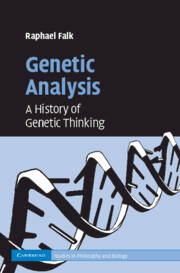Book contents
- Frontmatter
- Contents
- List of figures
- Acknowledgments
- Introduction
- PART I FROM REPRODUCTION AND GENERATION TO HEREDITY
- PART II FAKTOREN IN SEARCH OF MEANING
- PART III THE CHROMOSOME THEORY OF INHERITANCE
- PART IV GENES AS THE ATOMS OF HEREDITY
- PART V INCREASING RESOLVING POWER
- PART VI DEDUCING GENES FROM TRAITS, INDUCING TRAITS FROM GENES
- PART VII WHAT IS TRUE FOR E. COLI IS NOT TRUE FOR THE ELEPHANT
- Concluding comments
- Bibliography
- Index
PART II - FAKTOREN IN SEARCH OF MEANING
Published online by Cambridge University Press: 07 August 2009
- Frontmatter
- Contents
- List of figures
- Acknowledgments
- Introduction
- PART I FROM REPRODUCTION AND GENERATION TO HEREDITY
- PART II FAKTOREN IN SEARCH OF MEANING
- PART III THE CHROMOSOME THEORY OF INHERITANCE
- PART IV GENES AS THE ATOMS OF HEREDITY
- PART V INCREASING RESOLVING POWER
- PART VI DEDUCING GENES FROM TRAITS, INDUCING TRAITS FROM GENES
- PART VII WHAT IS TRUE FOR E. COLI IS NOT TRUE FOR THE ELEPHANT
- Concluding comments
- Bibliography
- Index
Summary
On March 26, 1900, a notice, Sur la loi de disjunction de hybrids [Concerning the law of segregation of hybrids] appeared in the Compes Rendus de l'Academie de Sciences. Its author, the well-known Dutch botanist Hugo de Vries, stated:
According to the principles which I have expressed elsewhere (Intracelluläre Pangenesis, 1889) the specific characters of organisms are composed of separate units. One is able to study, experimentally, these units either by the phenomena of variability and mutability or by the production of hybrids.
de Vries (1950 [1900], 30)In this short notice, de Vries reminded his readers of his hypothesis of reproduction and generation, according to which an organism may be reduced to preformed units in the gametes that will unfold into mature organs at embryogenesis. His thesis, however, suggests that, besides the morphogenists' tradition of the study of these units “by the phenomena of variability and mutability,” an effective research method is offered by the hybridist tradition, namely, hybridization. This notice presents the segregation principle of the progeny of monohybrids, of “75 per 100N and 25 per 100B” of the dominant character to that of the recessive character.
A more detailed report, submitted twelve days earlier, on March 14, 1900, as a preliminary communication to the Berichte der deutschen botanischen Gesellschaft, was published after the short notice:
Of the two antagonistic characteristics, the hybrid carries only one, and that in complete development. Thus in this respect the hybrid is indistinguishable from one of the two parents. There are no transitional forms.
[…]
- Type
- Chapter
- Information
- Genetic AnalysisA History of Genetic Thinking, pp. 39 - 43Publisher: Cambridge University PressPrint publication year: 2009



